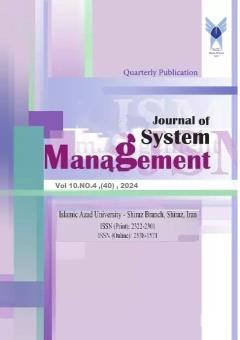Designing the Quantum Curriculum Leadership Model in Farhangian University: A Mixed Method Study
محورهای موضوعی : Entrepreneurship and Innovation
Javad Solimanpour
1
,
Rohollah Kashavarz
2
![]() ,
Esmail Kazempour
3
,
Esmail Kazempour
3
![]()
1 - Department of educational Sciences, Tonekabon Branch, Islamic Azad University, Tonekabon, Iran
2 - Ph.D. Student of Educational Management, Department of Educational Sciences, Tonekabon Branch, Islamic Azad University, Tonekabon, Iran.
3 - Department of Educational Sciences, Tonekabon Branch, Islamic Azad University, Tonekabon, Iran.
کلید واژه: Curriculum Leadership, Quantum leadership, Quantum Curriculum Leadership, Model,
چکیده مقاله :
The principles and concepts of the quantum theory have been extensively developed and have become a paradigm in various disciplines, including management and leadership sciences. This is particularly evident in management leadership of educational organizations within universities. Universities must restructure their management leadership methods to effectively address issues and align with the successful higher education systems of other countries. The present study aimed to design a model of quantum curriculum leadership at Farahangian University. The research design was mixed-methods, with an exploratory approach in the qualitative section and a descriptive-correlational approach in the quantitative section. The qualitative section included professors of educational sciences and administrators as experts, while the quantitative section included all professors of educational sciences from Farhangian University. The sample size in the qualitative section was 17 interviewees (faculty members) selected through purposive sampling based on saturation principle, and in the quantitative section, it was 283 individuals selected through cluster random sampling. Data collection tools in the qualitative section consisted of semi-structured interviews, and in the quantitative section, a researcher-made questionnaire with 135 items derived from theoretical foundations, research background, and experts’ interviews. In the qualitative section, validity was assessed through expert judgment, and reliability was assessed through test-retest and internal consistency. In the quantitative section, content validity, structural validity, and reliability were assessed using Cronbach's alpha and composite reliability, indicating the validity and reliability of the instruments. Data analysis in the qualitative section involved grounded theory analysis, while in the quantitative section, descriptive and inferential statistics (Kolmogorov-Smirnov test, Index values and Path analysis) were used. The results of the Kolmogorov-Smirnov test indicated that these assumptions were confirmed (p> 0.05). The findings of the study also showed that the presented model is a good fit. The findings revealed that quantum curriculum leadership consists of two factors including dimensions and components; causal conditions including planning in the higher education system and evaluation of quantum curriculum; and consequences including learning and professional development. The strategies include managerial, applied education, and executive organization, while the context includes environmental, economic, and scientific factors. The obstacles include technology, concentrated education, and structured organization.
The principles and concepts of the quantum theory have been extensively developed and have become a paradigm in various disciplines, including management and leadership sciences. This is particularly evident in management leadership of educational organizations within universities. Universities must restructure their management leadership methods to effectively address issues and align with the successful higher education systems of other countries. The present study aimed to design a model of quantum curriculum leadership at Farahangian University. The research design was mixed-methods, with an exploratory approach in the qualitative section and a descriptive-correlational approach in the quantitative section. The qualitative section included professors of educational sciences and administrators as experts, while the quantitative section included all professors of educational sciences from Farhangian University. The sample size in the qualitative section was 17 interviewees (faculty members) selected through purposive sampling based on saturation principle, and in the quantitative section, it was 283 individuals selected through cluster random sampling. Data collection tools in the qualitative section consisted of semi-structured interviews, and in the quantitative section, a researcher-made questionnaire with 135 items derived from theoretical foundations, research background, and experts’ interviews. In the qualitative section, validity was assessed through expert judgment, and reliability was assessed through test-retest and internal consistency. In the quantitative section, content validity, structural validity, and reliability were assessed using Cronbach's alpha and composite reliability, indicating the validity and reliability of the instruments. Data analysis in the qualitative section involved grounded theory analysis, while in the quantitative section, descriptive and inferential statistics (Kolmogorov-Smirnov test, Index values and Path analysis) were used. The results of the Kolmogorov-Smirnov test indicated that these assumptions were confirmed (p> 0.05). The findings of the study also showed that the presented model is a good fit. The findings revealed that quantum curriculum leadership consists of two factors including dimensions and components; causal conditions including planning in the higher education system and evaluation of quantum curriculum; and consequences including learning and professional development. The strategies include managerial, applied education, and executive organization, while the context includes environmental, economic, and scientific factors. The obstacles include technology, concentrated education, and structured organization.


